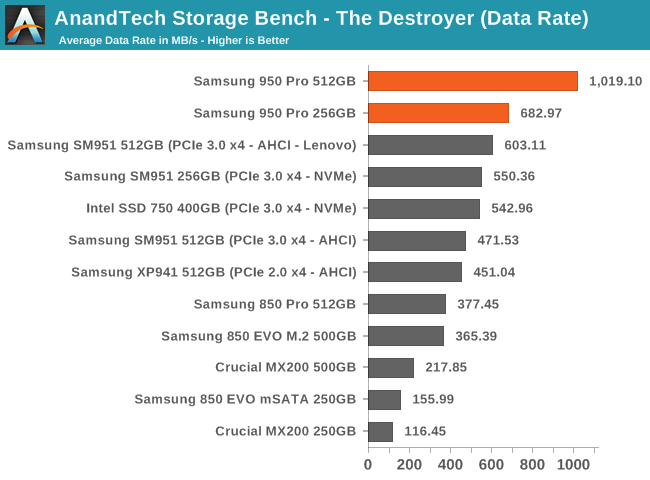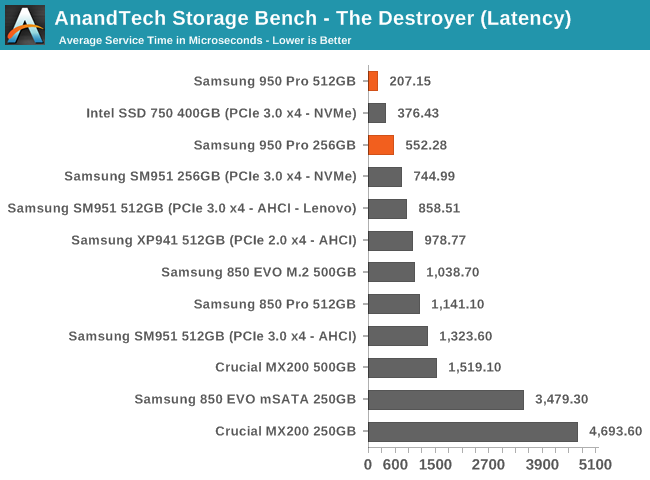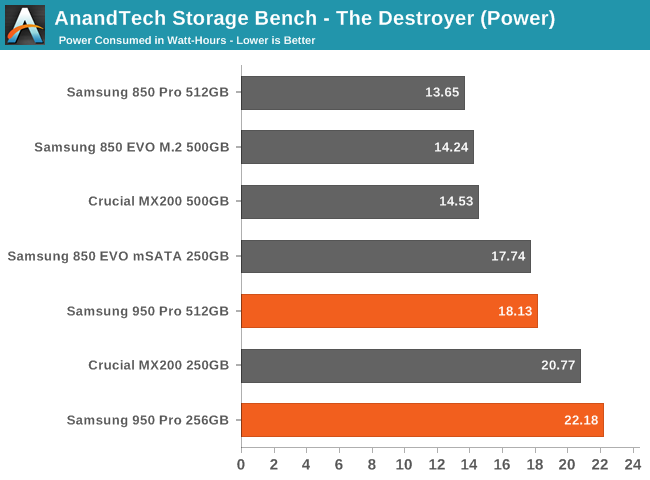The Samsung 950 Pro PCIe SSD Review (256GB and 512GB)
by Billy Tallis on October 22, 2015 10:55 AM ESTAnandTech Storage Bench - The Destroyer
The Destroyer is an extremely long test replicating the access patterns of heavy desktop usage. A detailed breakdown can be found in this review. Like real-world usage and unlike our Iometer tests, the drives do get the occasional break that allows for some background garbage collection and flushing caches, but those idle times are limited to 25ms so that it doesn't take all week to run the test.
We quantify performance on this test by reporting the drive's average data throughput, a few data points about its latency, and the total energy used by the drive over the course of the test.

Both 950 Pros deliver great performance on the destroyer, but the 512GB is outstanding. Clearly the more bursty nature of this test allows the drive to avoid any thermal throttling and deliver the high peak speeds that the PCIe interface is supposed to enable.

The NVMe drives deliver the lowest average service times, but the other PCIe drives are close behind. If there were any moments of thermal throttling like we saw with the performance consistency test, they would greatly inflate the average service time.

The very small number of performance outliers on this test is a good indicator that these drives don't sieze up under the pressure of an interactive workload.

When looking at the more strict latency threshold of 10ms, the 256GB 950 Pro is not significantly better than the good SATA drives, but the 512GB has extremely good control over latency.

Energy usage is not competitive with the high-performance SATA drives. As demanding as it is, The Destroyer still has opportunities for drives to scale back power consumption but the 950 Pro can't do that on our testbed.










142 Comments
View All Comments
Billy Tallis - Thursday, October 22, 2015 - link
If I'd had more time, I probably would have done more informal testing on some older machines. I can at least assure you that the drive doesn't seem to have any trouble in a PCIe 2.0 x2 M.2 slot on my personal Haswell machine. Next time I'm poking around in my Lynnfield server I'll be checking how the pcie drives work, especially power management. But I probably won't do a full suite of performance tests, just enough to get a rough idea for how fast drives perform on a slower link. And I really don't have a clue when I'll get around to this, because I've still got quite the backlog of drives to review.hansmuff - Thursday, October 22, 2015 - link
Understandable, thanks for the PCIe 2.0 update.The_Assimilator - Thursday, October 22, 2015 - link
Thermal throttling is disappointing but shows that M.2, like SATA Express, is DOA. PCIe drives with heatsinks, or preferably U.2, is the future - hopefully with the Z200 series chipsets, manufacturers will ditch SATAe in favour of U.2 and we can finally get a worthy successor to SATA3.MrSpadge - Thursday, October 22, 2015 - link
DOA it certainly is not. You're free to attach a tiny RAM heatsink on the drive and be fine. Or simply forget about throtteling in real world usage (unless you use it in a server).Redstorm - Thursday, October 22, 2015 - link
Under a normal client workload you don't get anywhere near triggering the thermal protection so adding heat sinks is not required. Agree SATA Express was still born. M.2 is far from it, if you look at any new release ultrabook you will find a M.2 SSD under the lid.The_Assimilator - Friday, October 23, 2015 - link
M.2 is a great solution for replacing 2.5" SSDs in space-limited applications like ultrabooks, but for *absolute maximum performance without thermal throttling*, 2.5" U.2 drives a la Intel's 750 are still the way to go.zodiacfml - Sunday, October 25, 2015 - link
It depends on the designer on how much throttling they would allow or not. U.2 allows more freedom though but I reckon would be much more expensive and less dense in the future.user_5447 - Thursday, October 22, 2015 - link
Why everyone keep saying that BIOS/UEFI must support NVMe to boot into OS?You can install GRUB bootloader on cheap small USB flash drive and use it to boot from NVMe drives on any system, since GRUB itself supports NVMe for few years now.
And yes, GRUB supports booting into Windows 8.1 / 10.
bji - Thursday, October 22, 2015 - link
They say it because it's true. Nobody wants to have to manage a USB drive just for booting their system. You can also install a floppy drive and boot from that, would you recommend that also? How about keeping a separate computer up constantly to support PXE booting from the network? Would you recommend that level of headache to someone who just wants to boot their frickin computer?bji - Thursday, October 22, 2015 - link
By the way, of all of the things I have to deal with when installing/upgrading Linux systems, grub is the most painful and problematic, by MANY orders of magnitude. I would *NEVER* recommend that a non-technical user have anything to do with grub, especially not for something as silly as booting a PC into Windows off of an NVMe drive.